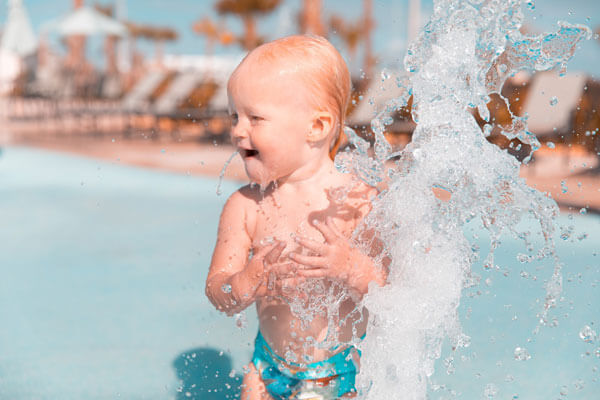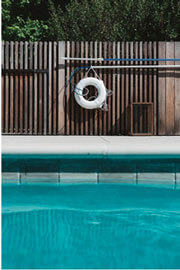
Pool Area Maintenance Tasks You Shouldn’t Skip
Even diligent pool owners miss key maintenance steps. Use this checklist to catch commonly forgotten tasks and keep your pool area safer and more efficient year-round.


A house with a pool can be an outstanding home to raise a child. They’re sure to make countless happy memories of pool parties and swimming with the family. Unfortunately, swimming alone is not safe for children of any age. And there are a few key steps that pool-owning parents should take to ensure their pool is safe and fun for everyone.
All-Safe was founded to keep children safe, and that’s what continues to drive us. Our pool safety tips for babies will help you stay safe when swimming, evaluate your pool area, and take the necessary steps to protect your children.
1.) Attention
When you and your baby are actively using the pool, your focused, distraction-free supervision is the most important safety measure. They may seem secure on a floatation device, but you’ll want to catch them immediately if their head ever dips below water to prevent drowning.
2.) Life Jackets
Make sure your baby wears a United States Coast Guard-approved life jacket or personal floatation device that’s appropriate for their weight at all times. Follow this important pool safety tip for babies as they age into toddlers, even after they start swimming lessons.
3.) Stay Close
Always remain within arms’ reach of your child, whether they’re a baby floating in a swim ring or a canopy or a toddler swimming on their own. When young children are in the water, seconds count, so vigilant attention and remaining nearby are paramount.
4.) Pool Fences

It’s simply essential to have a pool fence for babies. Even if they aren’t old enough to travel to the pool area on their own, they soon will be.
Making your pool inaccessible to your baby is the key. If your child can open the door leading to the pool and there are no barriers, then your child is not safe.
A mesh pool fence helps reduce this risk. All-Safe’s mesh is a tightly woven, see-through, and durable material that deters climbing and attaches to poles with spaces too small for babies to fit through. The tension-based system makes it very difficult for children to remove the fencing without an adult’s help.
5.) Pool Nets
Pool safety for babies doesn’t stop at fencing, however. Gates can be left open or unlatched, or particularly determined toddlers can push toys up to the wall to unlock the gate and be in the water in seconds. A pool gate alarm can help with this but shouldn’t be used alone.
Pairing a fence with a pool net adds another layer of safety to your pool area. Pool nets are also tension-based and attach to your deck with sturdy anchors. These nets are independently tested to hold up to 485 pounds, with holes roughly 3 ½ inches wide, too small for babies’ heads to fit through.
6.) Pool Alarms and Other Tools
As a final layer of protection, and never to be used alone, a pool alarm can add to the safety of your pool for your baby. These alarms either attach to the side of the pool to detect submersion or float on the surface of the water to detect movement. Proper usage and being able to hear the alarm from all areas of your home and yard are essential.

Additionally, be sure to have standard life-saving equipment stored near your pool in an easy to access and clearly labeled area. These tools include a floating life ring, shepherd’s crook, and rescue tubes. Check this equipment frequently for signs of wear.
Whether you need a pool fence, net, alarms, or all three, trust All-Safe to help with pool safety for your babies. Contact us to schedule your free consultation, and one of our local dealers will send a professional to help you decide on the best safety equipment for your unique needs.

Even diligent pool owners miss key maintenance steps. Use this checklist to catch commonly forgotten tasks and keep your pool area safer and more efficient year-round.

Learn the most common pool winterizing mistakes and how to avoid them for a safer, cleaner backyard during the off-season.

Mesh pool covers offer reliable winter protection by keeping out debris and preventing accidents. Learn why they’re a smart choice for safety and peace of mind.
Enter your zip code to locate an independent installer in your area
Enter your zip code to locate an independent installer in your area

Due to the many variations in monitors, phones, and browsers, color samples and product examples may appear different on different screens. Computers and mobile devices are not all calibrated equally and color reproduction on the Internet is not precise. The same is true for printed items such as brochures and other sales literature.
In addition, the colors of our products photograph differently under different lighting conditions. For example, photos taken in full sunlight will vary from photos taken on a cloudy or overcast day. Similarly, shadows from nearby objects can affect the color and transparency of our products. If a precise color or specific shade is important, please inspect the actual color of your product prior to installation.
Many of our products’ materials are not available through typical stores and vendors and therefore must be custom manufactured specifically for our use. In order to control costs and provide you with the best value possible, our raw materials are produced in large batches and can often take several months to receive. The colors of our materials can, and often do, vary slightly from batch to batch. Although we make every effort to minimize color variations, we cannot be responsible for these differences when they occur. If a precise color or specific shade is important, please inspect the actual color of your product prior to installation.
For example, we use the name “putty” to describe some of our products. Your idea of the color “putty” may be different than someone else’s idea of “putty”. In addition, products may have the same color name but may not be the exact same color. For example, we have different shades of “black”. Please do not order using color names as your only guide. If a precise color or specific shade is important, please inspect the actual color of your product prior to installation.
If it is important that your product be an exact color or shade, it is highly recommended that you inspect the actual product prior to its installation and address any concerns with your local independent installer. Most independent installers do not offer refunds or accept returns due to color variations.